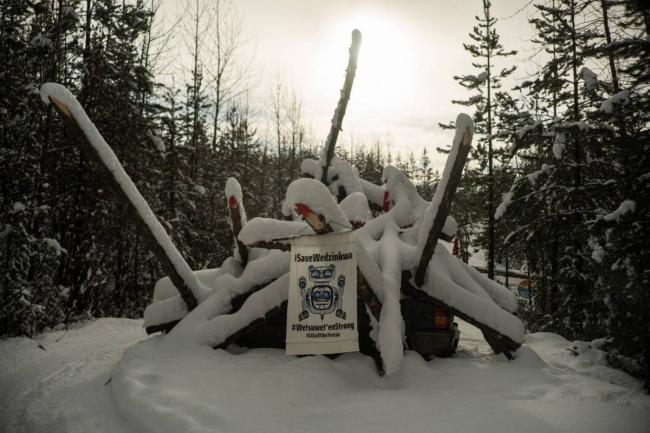For the third time in as many years, the settler government of B.C. has violently attacked and arrested unarmed Indigenous land defenders and journalists near Wedzin Kwa, the sacred waterway located on the unceded traditional territories of the Wet’suwet’en First Nation.
The violent assault targeted Gidimt’en checkpoints and blockades aimed at preventing Coastal Gaslink from building a pipeline through its territory that will transport dangerous “fracked” gas to the coast.
Deploying heavily armed RMCP against the Gidimt’en checkpoints was in “blind defence of fossil fuel expansion…while BC is in a state of emergency due to climate crisis that the entire world is watching,” stated the Union of B.C. Union of Indian Chiefs in its condemnation of the government’s action.
In deploying violence against the Wet’suwet’en for a third time, based on a court injunction obtained by Coastal GasLink (the private company building the pipeline), the government this time justified its actions through a deliberate campaign of misinformation.
In 2020, the B.C. government denied it had anything to do with the deployment of the RCMP to Wedzin Kwa—Premier John Horgan stated that “the rule of law needs to prevail in B.C.,” but that the government was not directing the RCMP to enforce a provincial injunction.
This lie was later exposed when the Wet’suwet’en, BC Civil Liberties Association, and the Union of B.C. Indian Chiefs released a letter from Mike Farnworth, Minister of Public Safety and Solicitor General, to then deputy RCMP commissioner Jennifer Strachan declaring a “provincial emergency” and authorizing redeployment of the RCMP to violently suppress the rights of the Wet’suwet’en.
This time, Farnworth and his advisers decided to get in front of the game. In a statement justifying police repression, Farnworth asserted that Gidimt’en actions were putting at risk “500 Coastal GasLink workers”.
Nonsense. The Gidmit’en had issued an eviction notice asking the Coast GasLink workers to safely and peacefully evacuate Wet’suwet’en territory. This order was deliberately ignored by CGL and the government, putting the workers at risk. Instead of informing the workers, the government sicked the dogs of war against the unarmed Gidimt’en and their allies.
Using the 500 CGL workers as a wedge against the Wet’suwet’en is audacious but not surprising. The NDP government thinks it can use its historical ties to the labour movement to engage in violence against the unarmed land protectors. This only underscores how far the government has sunk and the risks it is willing to take to impose its settler agenda.
But the government may have overplayed its hand.
Like the Gidimt’en, the B.C. labour movement knows full well what an injunction means—it has been used systematically to repress workers in the province, a fact well documented in Rod Mickleburgh’s recent On the Line: A History of the British Columbia Labour Movement. Moreover, the labour movement is aware of the need to respect Indigenous sovereignty and the impact of the climate emergency.
The B.C. Federation of Labour has stated: "We will consider what it means to live and work in a colonial province and country. We will look at how labour in British Columbia and beyond can play a more effective role in dismantling those structures of oppression and serve as better allies to Indigenous peoples. And we will recommit to the work of decolonization, within our own walls and in the broader community.”
The NDP government is hoping that the B.C. Federation of Labour will back down on these commitments and not speak out about what is happening in the north. This is despite the fact that the government and CGL, not the Gidimt’en, have endangered the CGL workers by violently enforcing an injunction for a pipeline through the unceded territory of the Wetsuwet’en.
Will the B.C. Federation of Labour look the other way given its commitment to “making the profound, urgent changes we need to forestall even worse calamities by addressing climate change?” Can it afford to stand by when the LNG Canada project alone will emit four megatonnes of greenhouse gas emissions every year—the equivalent of adding nearly a million additional cars to roads every 365 days.
Recent evidence suggests that government is severely underestimating current methane emissions. That is why almost every environmental group in the province, including the Canadian Association of Physicians for the Environment, have condemned the province’s fossil-fuel expansion plans.
White fragility
In deploying violence against Gidimt’en, the provincial government is doing exactly what settler governments have been doing ever since the British empire laid claim to the lands now called “British Columbia”.
The current government pursues an economic model based on a resource-extraction paradigm that has been the modus operandi of colonial governments since their inception in 1849. That paradigm has been largely responsible for the pillage of the forests and seas to the point that the Earth is now exacting its revenge through extreme weather events including heat domes, wildfires, and flooding now afflicting the province.
It may be tempting to describe as “tragic irony” that those who seek to stop the colonial model and help heal the Earth are now in jail, but that would obscure the fact that the colonial system is doing exactly what it was designed to do—violently dispossess First Nations of their sovereignty.
In 2018, the provincial and federal governments agreed on a Principals' Accord with the First Nations Summit in which it recognized “the pre-existence of First Nations as sovereign peoples with title and rights to lands and resources remains fundamental to resolving this outstanding land question.”
Yet when push comes to shove, the province repudiates Indigenous sovereignty, imposes its own sovereignty over First Nations, and makes a mockery of its own promises.
In the end, the NDP government like its colonial predecessors, continues to rely on its own colonial powers founded on the outdated but still potent Doctrine of Discovery that remains the fragile basis of Crown sovereignty today as it was in 1846 when the British colonial office negotiated the Treaty of Oregon.
This, despite the fact the NDP elected more Indigenous and racialized people to the legislature than ever before.
Those members, however, are not at the centre of power—key government positions remain in the hands of people whose hands, like mine, are as white as the driven snow.

